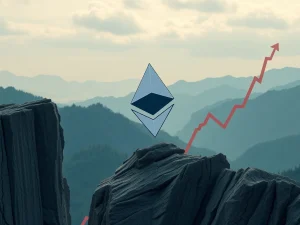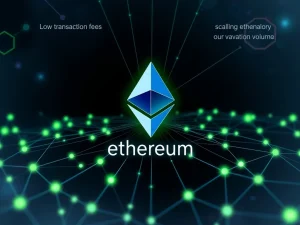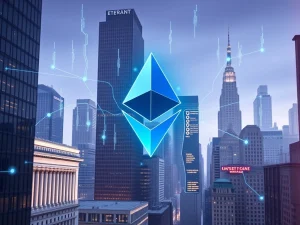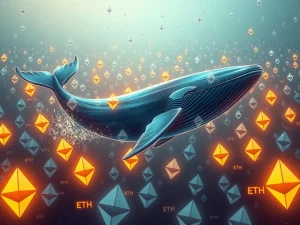Unveiling the Essential Truth: Layer 1, Not Layer 2, is Key to Revolutionary EVM Scaling

Is the Ethereum Virtual Machine (EVM) reaching its breaking point? When CryptoKitties caused chaos on the Ethereum network back in 2017, it highlighted a critical issue: blockchain scalability. Fast forward to today, and the problem is magnified. With billions locked in DeFi and NFTs constantly changing hands, the EVM, the engine of this crypto activity, is feeling the strain. For years, Layer 2 solutions have been championed as the answer, but are they truly solving the core problem, or just masking it? This article dives deep into why the real solution for EVM scaling might not be where everyone is looking.
The Layer 2 Illusion: Why It’s Not the Real Solution for EVM Scaling
Layer 2 blockchains promised to be the saviors of Ethereum performance, designed to lighten the load on the main Ethereum chain. By processing transactions off-chain and then reporting back, they seemed like a smart way to boost speed and lower costs. However, Layer 2s have turned out to be more of a band-aid than a cure. The sheer number of new Layer 2s emerging—a new one every 19 days in 2024 according to Gemini—isn’t a sign of progress. It’s a symptom of a fragmented and increasingly complex landscape.
The Challenges with Layer 2s:
- Centralization Risks: Many Layer 2s rely on centralized sequencers. This introduces vulnerabilities like transaction censorship and reordering, undermining the decentralized ethos of blockchain.
- Interoperability Nightmares: Vitalik Buterin himself has pointed out the struggles Layer 2s face in working smoothly together. This lack of interoperability leads to fragmented liquidity and a confusing experience for users.
- Native Rollup Drawbacks: Even advanced designs like native rollups, intended to fix centralization, come with their own problems. They can siphon value away from projects, potentially hindering adoption.
Considering these hurdles, is it wise to keep piling resources into Layer 2s, or should we reconsider our approach to blockchain scalability?
Beyond TPS: A Revolutionary Metric for True Blockchain Performance
To truly understand how to build better blockchains, we need to rethink how we measure performance. The traditional metric, Transactions Per Second (TPS), is flawed. It’s like judging cars solely on their top speed without considering fuel efficiency or handling. Why? Because not all transactions are created equal. A simple Ether (ETH) transfer uses 21,000 units of gas, while an ERC-20 transfer needs 65,000. TPS doesn’t account for this difference in computational effort.
Introducing “Gas Per Second”:
A more accurate metric is “gas per second.” This measures the amount of gas a network can process per second, giving a far better picture of its actual computational capacity across various transaction types. While TPS might be okay for simple ETH transfers, gas per second provides a comprehensive view of network throughput, even for complex operations. Adopting gas per second as a standard will be a significant step forward in honestly evaluating and improving Ethereum performance and beyond.
Layer 1: The Overlooked Foundation for Unlocking EVM Scaling
For too long, Layer 1s have been overshadowed in the quest for EVM scaling. Many believed rollups were the only path forward. However, Layer 1s are the bedrock of the entire crypto ecosystem. They are the key to truly scaling the EVM to meet future demands. Instead of just building on top, we need to go back to the fundamentals and rebuild the EVM itself, prioritizing performance from the ground up.
How Layer 1s Can Revolutionize EVM Scaling:
- Parallelization: Implementing parallel processing can dramatically increase throughput, allowing Layer 1s to handle significantly more transactions simultaneously.
- Optimized Consensus Mechanisms: Transforming the EVM’s consensus mechanism can reduce bottlenecks and improve efficiency.
- Efficient Storage Solutions: Upgrading storage solutions will further enhance performance and create a more developer-friendly environment.
By focusing on these core Layer 1 improvements, we can set a new standard for blockchain scalability and unlock the EVM’s full potential.
The Definitive Solution: Layer 1 is the True Path to EVM Scaling
Layer 2s have been presented as the quick and easy fix for EVM scaling for years. But they are not the ultimate answer. The real, long-term solution has always been, and remains, in strengthening Layer 1s. It’s time to shift our focus, embrace more accurate performance metrics like gas per second, and dedicate our efforts to refining the foundational layer. This is how we will pave the way for the EVM to reach unprecedented levels of scalability and efficiency, securing its future as the powerhouse of decentralized applications. The EVM is here to stay, and its evolution depends on our willingness to build stronger foundations.
Opinion by: Jay Jog, co-founder of Sei Labs. This article is for general information purposes and is not intended to be and should not be taken as legal or investment advice. The views, thoughts, and opinions expressed here are the author’s alone and do not necessarily reflect or represent the views and opinions of Crypto News Insights.









